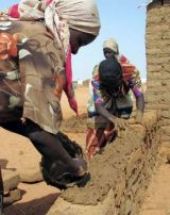Refugees in south Darfur face more misery as rains come
LABADO, south Darfur, May 26, 2005 (Christian Aid) — The two-hour drive from Nyala in south Darfur to the former rebel stronghold of Labado provides a snapshot of the devastating military tactics used by both rebels and the Sudanese government and its ally, the Janajaweed.

|
|
Internally displaced Sudanese women lay bricks to build a better shelter for protection against the upcoming rainy season in Abu Shouk refugee camp, home of some 100,000 refugees in Sudan’s troubled western province of Darfur May 26, 2005. (Reuters). |
It is a scene of utter desolation, not a human being or animal to be seen. All the villages are abandoned and many are burnt-out. Scorched pots lie on the ground; the constant wind blows sand into the empty, forlorn huts. The once fertile fields still have the stubble from last year’s crops.
This is just the prelude to Labado. In early December it was the scene of a battle which was part of the government’s scorched-earth campaign to force the rebels from villages they were occupying. Rebels from the Sudan Liberation Army (SLA) launched a surprise attack on government troops; they retaliated by pounding Labado with helicopter gunships and mortar fire.
But it was the civilians who were caught in the middle. Some 30,000 fled the area. After the battle eyewitnesses described Labado as empty and destroyed.
Some have now returned to Labado. They are now internally displaced persons (IDPs) in their own village. Most have built makeshift shelters next to the scorch marks on the sand, indicating where their homes stood before the attack.
Halima Salh Hasan, 40, fled with her five children to Sheriya, a journey which took them three days on foot. They are now living in a shelter made of sticks and rags next to a burnt-out spot in the sand showing the shape of her previous home.
‘Before we had fields and animals,’ she said. ‘Now I am too frightened to go to the fields.’
Her eldest daughter, Saida Yama lives close by with her husband and 17-month-old baby. Her shelter is made of sticks and matting. Just in front are the burnt walls of her mud hut, the thatched roof went up in smoke.
‘I worry about my house that was burnt, I worry about the rains,’ she said. Everyone is worried about the imminent rainy season – none of these shelters will withstand heavy rain and strong winds.
The ACT/Caritas programme, supported by Christian Aid, is providing plastic sheeting, jerricans and soap. Another Christian Aid partner, the Sudan Council of Churches, has set up tents so that the children can continue their education. Their school is one of the few structures not destroyed, but it is now home to the forces of the African Union (AU).
The presence of the AU is one of the reasons many people have come back home, but it has not stopped the attacks or rapes people suffer when they venture out of the village.
The mandate of the AU is primarily a monitoring one – providing only for it ‘to protect civilians whom it encounters under imminent threat and in the immediate vicinity’. Unless the AU mandate is strengthened, it is difficult to see how the IDPs will feel secure enough to return home.
On the drive back from Labado to Nyala another village was burning – proof that the conflict is never very far away in Darfur.
